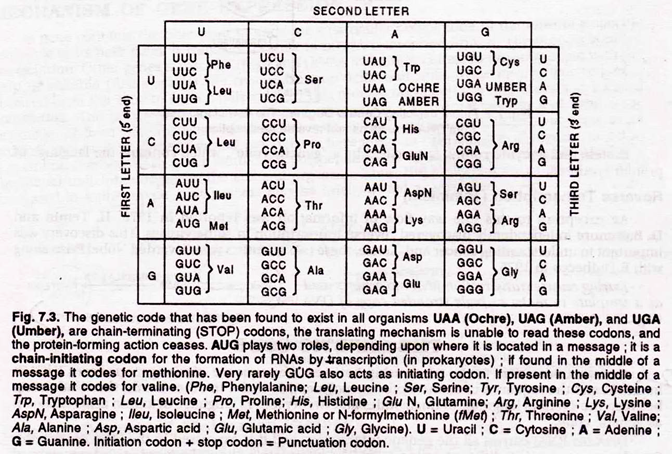Let us discuss about the genetic code. The eight important properties of genetic code are:
(1) Code is a Triplet (2) The Code is Degenerate (3) The Code is Non-overlapping (4) The Code is Comma Less (5) The Code is Unambiguous (6) The Code is Universal (7) Co-linearity and (8) Gene-polypeptide Parity.
Genetic Code refers to the relationship between the sequence of nitrogenous bases (UCAG) in mRNA and the sequence of amino acids in a polypeptide chain. In other words, the relationship between the 4 letters language of nucleotides and twenty letters language of amino acids is known as genetic code.
DNA (or RNA) carries all the genetic information and it is expressed in the form of proteins. Proteins are made of 20 different amino acids. The information about the number and sequence of these amino acids forming protein is present in DNA, and during transcription is passed over to mRNA. The form in which it is transferred was not understood for long.
Sugar (pentose) and phosphate of DNA could not perform this job of passing on the genetic message to mRNA because sugar is only of one type and so also the phosphate. This leaves only four nucleotides to form the message for 20 amino acids, but 4 nucleotides are too few for twenty amino acids.
This difficult problem was solved with the discovery that a codon (hereditary unit of a gene) containing coded information for one amino acid consists three nucleotides (i.e., a triplet code). Thus for twenty amino acids, 64 (4 x 4 x 4 or 43 = 64) possible permutation are available. This break through resulted into 64 codons dictionary — the Genetic Code.
According to Bark (1970) the genetic code is a code for amino acids, specifically it is concerned with as to what codons specify what amino acids. Genetic code is the outcome of experiments performed by M. Nirenberg, S. Ochoa, H. Khorana, F. Crick and Mathaei. Professor M. Nirenberg was awarded Nobel Prize in 1961 for this outstanding work.
The dictionary of genetic code employs the letters in RNA (U, C, A, G, i.e., A = Adenine, U = Uracil, C = Cytosine, G = Guanine)
The codon for the amino acids, which are the same in all known life forms, have been determined experimentally. They are given in Fig. 7.3.
In Fig. 7.3 note that more than one codon can signal a particular amino acid to be incorporated into a protein. In addition, some codons serve special functions.
For example, the codon AUG serves two functions:
(1) As an initiator codon signaling for the start of synthesis of a peptide, and
(2) For the incorporation of methionine into the growing chain of a peptide. Other special-purpose codons are UAA (Ochre), UAG (Amber), and UGA (Umber), all of which signal STOP.
When the ribosomal synthesis site encounters one of these stop codons, the peptide chain is released and assumes its secondary and tertiary structures. Since UAA (Ochre), UAG (Amber) and UGA (Umber) do not specify any amino acid they are also called nonsense codons.
“When preceded by an initiator region, the codon AUG signals: “Start a new peptide molecule beginning with N-formylmethionine, or fMet.” The codons UAA, UAG and UGA signal termination of the protein synthesis.”
Properties of Genetic Code:
The properties of genetic code determined by extensive experimental evidences may be summarized as follows:
1. Code is a Triplet:
As pointed out earlier, the coding units or codons for amino acids comprise three letter words, 4 x 4 x 4 or 43 = 64. 64 codons are quite adequate to specify 20 proteinous amino acids.
2. The Code is Degenerate:
The occurrence of more than one codon for a single amino acid is referred to as degenerate. A review of genetic code dictionary will reveal that most of the amino acids have more than one codon. Out of 61 functional codons, AUG and UGG code to one amino acid each. But remaining 18 amino acids are coded by 59 codons.
3. The Code is Non-overlapping:
In a non-overlapping code, the same letter {i.e., base) is not used in the formation of more than one codon.
4. The Code is Comma Less:
A comma less code means that no nucleotide or comma (or punctuation) is present in between two codons. Therefore, code is continuous and comma less and no letter is wasted between two words or codons.
5. The Code is Unambiguous:
There is no ambiguity in the genetic code. A given codon always codes for a particular amino acid, wherever it is present.
6. The Code is Universal:
The genetic code has been found to be universal in all kinds of living organisms — prokaryotes and eukaryotes.
7. Co-linearity:
DNA is a linear polynucleotide chain and a protein is a linear polypeptide chain. The sequence of amino acids in a polypeptide chain corresponds to the sequence of nucleotide bases in the gene (DNA) that codes for it. Change in a specific codon in DNA produces a change of amino acid in the corresponding position in the polypeptide. The gene and the polypeptide it codes for are said to be co-linear.
8. Gene-polypeptide Parity:
A specific gene transcribes a specific mRNA that produces a specific polypeptide. On this basis, a cell can have only as many types of polypeptides as it has types of genes. However, this does not apply to certain viruses which have overlapping genes.
